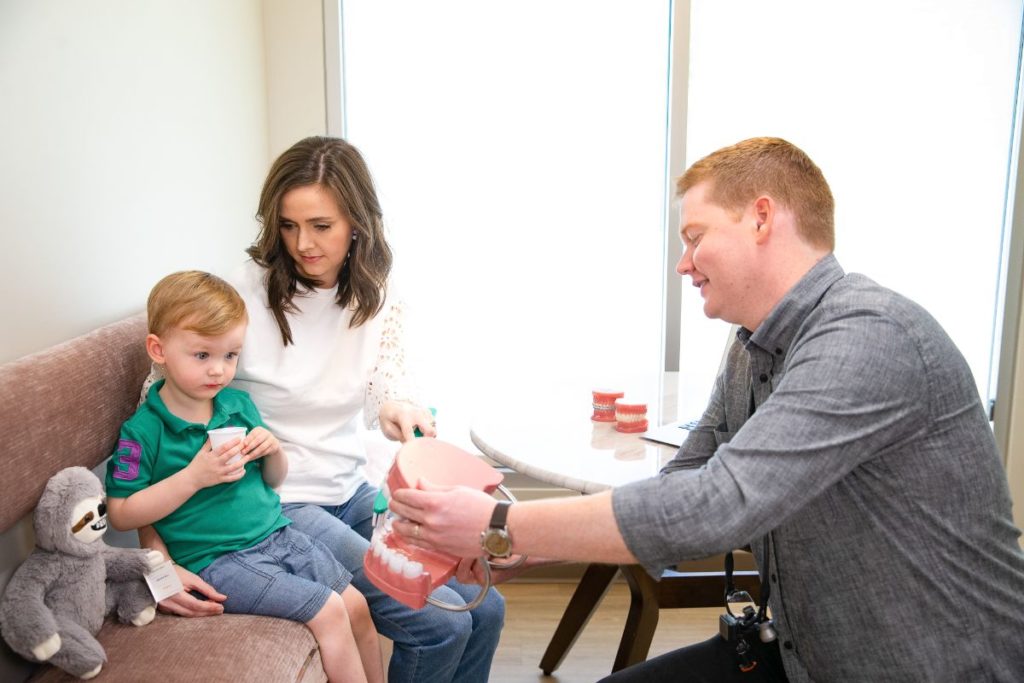Did you know that the enamel on our teeth is one of the toughest substances our bodies produce? It’s even stronger than our bones are! That means our teeth are extremely powerful in many ways, but they’re not indestructible. Teeth have a lot going for them, but they do lack one important skill—unlike every other tissue type in our bodies, teeth don’t have the ability to repair themselves. Injuries can be painful, unsightly, and may cause issues that are costly for a dentist or orthodontist to correct. For patients who wear braces, there’s the added stress of potentially damaging their orthodontic appliance.
If you have a child who plays sports, you’re probably no stranger to dental injuries. According to the American Academy of Pediatric Dentistry, sports cause almost 40% of all dental injuries in children, so it’s important to protect your child’s smile when they’re on the court or field. Here at Saddle Creek Orthodontics, we strongly recommend orthodontic mouthguards for our athletic patients wearing braces. This is the simplest and most effective way to protect their teeth and braces! While we prefer orthodontic mouthguards for our patients, some opt to use a regular instead. Let’s take a closer look at each of these options!

Orthodontic mouthguards vs. regular mouthguards
Regular and orthodontic mouthguards both offer protection for a patient in braces, but there are some important differences to be aware of when choosing the best option for your child. Regular mouthguards are made of a thermoplastic material that is designed to heat up in the mouth and mold around the teeth. This material will also mold around the brackets when a child wears braces.
This can be an issue in some cases. For example, if the molding fits too closely to the brackets, a forceful blow could knock them right off the teeth! Thermoplastic molding doesn’t allow for the movements teeth make during orthodontic treatment, either. Regular mouthguards can actually work against our progress in that way, and they’ll need to be replaced more often to keep up with the shifting of the teeth throughout the treatment process.
On the other hand, orthodontic mouthguards are designed with braces patients in mind. They’re better able to protect the brackets on the teeth and soften any hits they may take. These models are slightly larger to fit over braces, but they’re still very comfortable to wear. They use a high-grade silicone material that won’t mold around the teeth and brackets, which cushions the lips from bumping and rubbing against the teeth. We love this feature, as getting your lip caught in a bracket due to a fall or direct hit can be extremely painful! It can cause swelling and may even require help from Dr. Fagala or Dr. Boling to release it.
There’s a third option that falls somewhere in between regular and orthodontic mouthguards. Some over-the-counter mouthguards are made specifically for athletes who wear braces, including well-known brands like ShockDoctor, Gladiator, and Vettex. These can be found online and in many sporting goods stores. While these tend to run a bit more than regular mouthguards, any extra cost is worth it for the additional comfort and protection they provide! Nothing beats a customized orthodontic mouthguard, but we recommend these models over regular mouthguards (and a regular mouthguard over wearing no mouthguard at all.)
When should a mouthguard be worn?
Patients who play sports and wear braces should wear a mouthguard whenever they’re active. If they participate in contact sports, that means warm-ups, practices, and throughout games. Dr. Fagala and Dr. Boling recommend wearing a mouthguard just as frequently with non-contact sports, but the risks aren’t as high if the patient doesn’t. Athletes in clear aligners can benefit from mouthguards, too! Replacing aligners with a tight-fitting mouthguard can offer extra protection since the aligners fit more loosely over the teeth to allow for movement during treatment. Any time clear aligners are removed, they should be placed somewhere clean and safe, then put back in as soon as practice is complete or the game is over.
Caring for orthodontic mouthguards
When cared for properly, orthodontic mouthguards can last a long time. Because it’s easy for bacteria to grow on them, mouthguards should be cleaned well every time they’re removed. A soft toothbrush and toothpaste can be used to gently brush the inner and outer surfaces, while antimicrobial solutions make excellent bacteria-killing rinses. For a deeper clean, mouthguards can be left to soak overnight in a glass of water with a denture cleaner tablet. Like aligners, mouthguards should always be kept safe and dry in a case when they’re not being used.

Trust SCO for safer smiles
There are many benefits to your child playing organized sports: they help keep their body healthy, are great stress relievers, and allow kids to have fun while being part of a team. They do come with certain risks, though, including dental injuries that may result in costly and extensive treatment. Fortunately, there’s an easy way to reduce that particular risk! Mouthguards can help prevent trauma and orthodontic emergencies like:
- tooth damage
- tooth loss
- broken or chipped teeth
- abrasions or cuts on the cheeks, lip, or tongue
- broken brackets or wires
Orthodontic mouthguards are the best way to ensure your child’s teeth stay safe when participating in sports, but accidents can still happen sometimes. While true orthodontic emergencies tend to be rare, they do occur from time to time. When we talk about orthodontic emergencies, we’re generally referring to:
- any serious injury or trauma to the face, neck, mouth, teeth, or gums
- swelling, infection, or bleeding of the gums or mouth
- severe pain or discomfort in the teeth, mouth, face, or neck
If your child’s mouth takes a direct hit while playing sports (or any other time), let us know as soon as possible so Dr. Fagala or Dr. Boling can assess the damage and figure out the next step. Saddle Creek Orthodontics is proud to support young athletes in our community, and we’re committed to helping patients continue playing the sports they love while we help them achieve a more confident smile. To learn more about safely playing sports while wearing braces, get in touch any time! Our team will be happy to help you find an appropriate orthodontic mouthguard to meet your child’s needs. test
